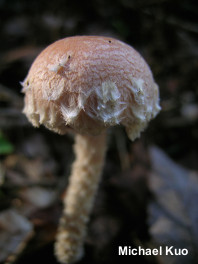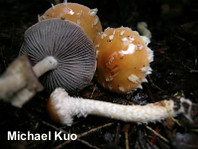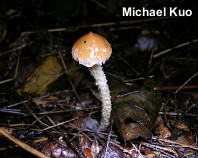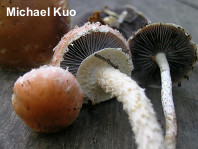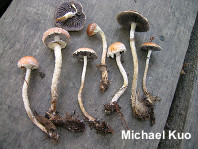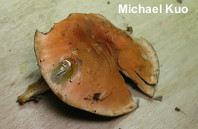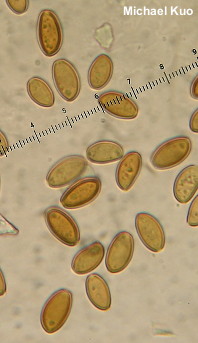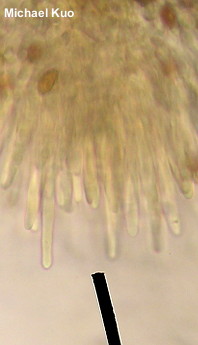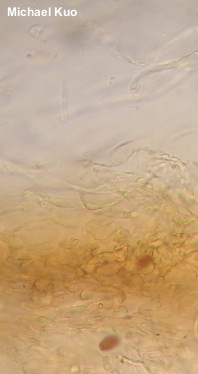| Major Groups > Gilled Mushrooms > Dark-Spored > Stropharioid Mushrooms > Leratiomyces squamosus var. thraustus |

|
Leratiomyces squamosus var. thraustus [ Basidiomycota > Agaricales > Strophariaceae > Leratiomyces. . . ] by Michael Kuo This rare but gorgeous mushroom appears in eastern North America, decomposing woody debris on the forest floor under hardwoods or conifers. It is also documented from Washington and Utah. Leratiomyces squamosus var. thraustus has a sticky cap that is a beautiful shade of orange and, when young, is adorned with tattered white remnants of the partial veil. The ringed stem is shaggy with white scales, and becomes brownish as the mushroom matures. Under the microscope, Leratiomyces squamosus var. thraustus lacks chrysocystidia but features abundant cheilo-leptocystidia. Similar species are typically not as orange, differ in habitat, or have different microscopic characters. Leratiomyces squamosus var. squamosus has a yellow-brown to creamy yellowish cap; it is otherwise identical to Leratiomyces squamosus var. thraustus. If you are on the West Coast, be sure to compare Leratiomyces squamosus var. thraustus with Leratiomyces ceres, which grows in woodchips in urban settings, is more orange-red, and features chrysocystidia. Stropharia thrausta, Psilocybe thrausta, Stropharia squamosa var. thrausta, and Psilocybe squamosa var. thrausta are synonyms. Description: Ecology: Saprobic; growing alone or gregariously on woody debris in hardwood and conifer forests; summer and fall; widely distributed in eastern North America, and documented from Washington and Utah; uncommon. The illustrated and described collections are from Ohio and Kentucky. Cap: 2–5 cm; hemispheric at first, becoming broadly convex; sticky to slimy when fresh; bald; dull pinkish orange when young, maturing to bright orange; at first covered with a whitish, tissue-like covering that aggregates into scales as the cap expands; margin usually adorned with white partial veil remnants. Gills: Broadly attached to the stem; close or nearly distant; short-gills frequent; whitish to pale gray at first, becoming dark purplish gray; with whitish edges when mature. Stem: 8–15 cm long; up to 1 cm thick; more or less equal; dry; with a ring that is grooved on its upper surface and is usually arched gracefully downwards and away from the stem; fairly bald above the ring, but densely scaly below; white at first, becoming brownish toward the base with maturity; base with white mycelial threads. Flesh: White, becoming brownish in the stem with age; not changing when sliced. Odor and Taste: Not distinctive. Chemical Reactions: KOH on cap surface olive to negative. Spore Print: Dark purple-blackish. Microscopic Features: Spores 10–14 x 5–7 µm; ellipsoid; with a small pore; smooth; thick-walled; yellow-brown in KOH. Basidia 4-spored. Cheilocystidia as leptocystidia; 65–100 x 3–5 µm; cylindric-flexuous with rounded or subacute apices; smooth; hyaline to yellowish in KOH; thin-walled. Pleurocystidia not found. Pileipellis an ixocutis above a subcellular subpellis; orangish brown in KOH. REFERENCES: (Kalchbrenner, 1873) Bridge & Spooner, 2008. (Saccardo, 1887; Stamets, 1978; Smith, Smith & Weber, 1979; Guzman, 1983; McKnight & McKnight, 1987; Phillips, 1991/2005; Lincoff, 1992; Barron, 1999; Noordeloos, 1999; Roody, 2003; McNeil, 2006; Miller & Miller, 2006; Spooner et al., 2008; Kuo & Methven, 2014.) Herb. Kuo 10010413, 10101004. This site contains no information about the edibility or toxicity of mushrooms. |
© MushroomExpert.Com |
|
Cite this page as: Kuo, M. (2017, September). Leratiomyces squamosus var. thraustus. Retrieved from the MushroomExpert.Com Web site: http://www.mushroomexpert.com/leratiomyces_squamosus_thraustus.html |
